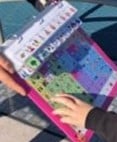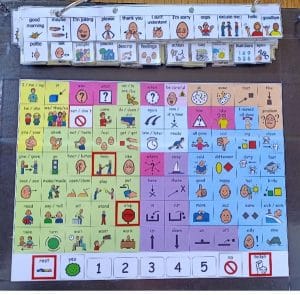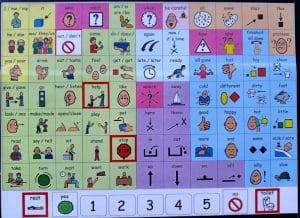 The most resourceful handbag
The most resourceful handbag
WHAT? A core board is a visual and tactile form of communication, allowing an individual to point to words to convey a message. It is a very successful tool to support an individual who is developing their language.
*Use of a core board will not stop your child from talking, but will instead increase the rate and opportunity for their communication to develop and grow! *
WHY? The core board is used by pointing to symbols as you say words. When you model to a child, they are provided with auditory (speech), visual (symbols), and tactile (touching) input. This means they can gain a greater understanding of words and then build their vocab as the words are available to them.

Your child may then wish to explore the core board by looking at all the colours and symbols and flicking through the fringe. This is great as they are learning more about the board. You can take advantage of these moments by modelling on the board as the look and saying words they are touching e.g. “you are looking at the words/pictures”.
WHERE? A core board consists of two components:
Core words are words we use in 80% of everyday common language to create messages for communication. These are arranged left to right on the board by alphabetical order and colour specific to the type of word as follows:
- Yellow – pronouns (naming words e.g. he, I, we, you, it)
- Green – verbs (doing words e.g. help, sit, go, stop, eat)
- Purple – prepositions (e.g. up, down, in, out, on, off)
The fringe tabs found across the top of the board consist of nouns and other detailing words to add to communication.
The first tabs include greeting and manner words and phrases (hello, I’m sorry, please), and conversation starters which give more detail to what the communicative intention is (I have an idea, it’s going to happen, something’s wrong). Other category or activity specific words can then be found such as:
people/names, places, colours, shapes, more describing words, feelings, more actions, food/drink, choices, body parts, animals, transport, cooking words, and school activities.
These words can be personalised for the individual by adding photos and names of particular people and places, certain foods they like to eat, toys they play with, and possibly other vocab relating to a specific activity such as horse riding. This can help draw familiarisation with words and interest in symbols and pictures as they can be recognised and commonly used e.g. “look there is John”, “Sarah is drinking chocolate milk”.
Using a Core board
HOW? When first using a core board it can be tricky just remembering to have it nearby to use, let alone learning where all the words are. As it is another thing to pack in the car or carry around, you may start with some simple goals from having it available on the dining table, to sitting it next to your child in different spots of the house, to using it throughout activities.
If you are ready to use it for modelling, start by choosing 2-3 words to focus on a time. You may choose some specific activities or routines in the day to practice using these words with your child. You can then build up to using multiple words at one time to create sentences such as “I want more chips”.
Model model model!! not only what you are saying, but what your child could say e.g. if your child is reaching to the pantry for a food item, grab the core board and model “I want chips”. This shows them the words they could use to ask.
See below for some ideas of what words to use in different activities:
| Activity | Focus words | What to say |
| Mealtime – when you are providing food to your child or they are indicating that they want food. | Eat Want More Sit Finished | “It is time to eat” “Do you want chips?” “Do you want more chips?” “sit down/at the table” “have you finished eating?” |
| Games/play – when interacting with your child and taking turns, stop/go games | My/your turn Stop Go More Finished | “it’s your turn” “stop!!” the car has stopped “ready set go!” “more bubbles” “the bubbles have finished” |
| Dressing/washing – when dressing your child, or during bath time/nappy change | Up/down Sit/stand Off/on Hot/cold Help | “put your arms up” (or down) “stand up for me” “pants off”, “nappy on” “the water is hot” “do you need help” |
| Cooking/packing/tidying – when you are baking together, packing a lunchbox, or tiding toys away | In/out Open/close More Finished Help | “put the flour in the bowl” “let’s open the box” “put more flour in” “we have finished cleaning up” “help me tidy up” |
Once you are familiar with the basic focus words, you can continue adding more vocabulary for example instead of just asking “do you want chips?” you can add “do you want hot chips?” and then even start commenting more such as “look you’ve got a big chip”, “I like chips”, “you look happy eating your chips”.
REMEMBER!
- Take your time to learn the words
- You can never do too much modelling
- Keep it fun and exciting
For demonstrations of modelling the core board, visit our videos page!!
Written by
Lacie Glen Vile
Speech Language Therapist


 The most resourceful handbag
The most resourceful handbag






